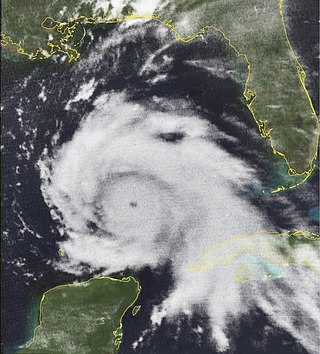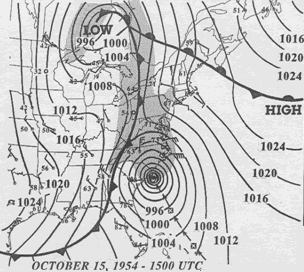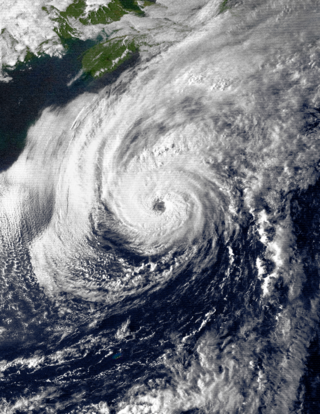
Hurricane Camille was a powerful, deadly and destructive tropical cyclone which became the second most intense on record to strike the United States and is one of the four Category 5 hurricanes to make landfall in the U.S.

Hurricane Hazel was the deadliest, second-costliest, and most intense hurricane of the 1954 Atlantic hurricane season. The storm killed at least 469 people in Haiti before it struck the United States near the border between North and South Carolina as a Category 4 hurricane. After causing 95 fatalities in the US, Hazel struck Canada as an extratropical storm, which raised the death toll by 81 people, mostly in Toronto. As a result of the high death toll and the damage caused by Hazel, its name was retired from use for North Atlantic hurricanes.

The Lockheed WC-130 is a high-wing, medium-range aircraft used for weather reconnaissance missions by the United States Air Force. The aircraft is a modified version of the C-130 Hercules transport configured with specialized weather instrumentation including a dropsonde deployment/receiver system and crewed by a meteorologist for penetration of tropical cyclones and winter storms to obtain data on movement, size and intensity.

Hurricane hunters, typhoon hunters, or cyclone hunters are aircrews that fly into tropical cyclones to gather weather data. In the United States, the organizations that fly these missions are the United States Air Force Reserve's 53rd Weather Reconnaissance Squadron and the National Oceanic and Atmospheric Administration's Hurricane Hunters. Such missions have also been flown by Navy units and other Air Force and NOAA units. Other organizations also fly these missions, such as Government Flying Service Hong Kong.

The 53rd Weather Reconnaissance Squadron, also known by its nickname, Hurricane Hunters, is a flying unit of the United States Air Force, and "the only Department of Defense organization still flying into tropical storms and hurricanes." Aligned under the 403rd Wing of the Air Force Reserve Command (AFRC) and based at Keesler Air Force Base, Mississippi, with ten aircraft, it flies into tropical cyclones in the Atlantic Ocean, the Caribbean Sea, the Gulf of Mexico and the Central Pacific Ocean for the specific purpose of directly measuring weather data in and around those storms. The 53rd WRS currently operates the Lockheed WC-130J aircraft as its weather data collection platform.

Hurricane Iniki was a hurricane that struck the island of Kauaʻi on September 11, 1992. It was the most powerful hurricane to strike Hawaiʻi in recorded history, and the only hurricane to directly affect the state during the 1992 Pacific hurricane season. Forming on September 5, 1992, during the strong 1990–1995 El Niño, Iniki was one of eleven Central Pacific tropical cyclones during that season. It attained tropical storm status on September 8 and intensified into a hurricane the next day. After abruptly turning north, Iniki struck Kauaʻi at peak intensity; it had winds of 145 mph and reached Category 4 status on the Saffir–Simpson hurricane scale.

Hurricane Cleo was the strongest tropical cyclone of the 1964 Atlantic hurricane season. It was the third named storm, first hurricane, and first major hurricane of the season. Cleo was one of the longest-lived storms of the season. This compact yet powerful hurricane travelled through the Caribbean Sea and later hit Florida before moving offshore Georgia into the Carolinas, killing 156 people and causing roughly $187 million in damage. Major damage was seen as far north as east-central Florida, with the heaviest rains falling along the immediate coast of the Southeast United States into southeast Virginia.

The 1944 Great Atlantic hurricane was a destructive and powerful tropical cyclone that swept across a large portion of the United States East Coast in September 1944. New England was most affected, though so were the Outer Banks, Mid-Atlantic states, and the Canadian Maritimes. The storm's ferocity and path drew comparisons to the 1938 Long Island Express, one of the worst storms in New England history.

Hurricane Bonnie was a major hurricane that made landfall in North Carolina, inflicting severe crop damage. The second named storm, first hurricane, and first major hurricane of the 1998 Atlantic hurricane season, Bonnie developed from a tropical wave that emerged off the coast of Africa on August 14. The wave gradually developed, and the system was designated a tropical depression on August 19. The depression began tracking towards the west-northwest, and became a tropical storm the next day. On August 22, Bonnie was upgraded to a hurricane, with a well-defined eye. The storm peaked as a Category 3 hurricane on the Saffir-Simpson Hurricane Scale, and around the same time, the storm slowed and turned more towards the north-northwest. A large and powerful cyclone, Bonnie moved ashore in North Carolina early on August 27, slowing as it turned northeast. After briefly losing hurricane status, the storm moved offshore and regained Category 1-force winds, although it weakened again on entering cooler waters.

James Louis Franklin is a former weather forecaster encompassing a 35-year career with National Oceanic and Atmospheric Administration (NOAA). He served as the first branch chief of the newly formed Hurricane Specialist Unit (HSU) before his retirement in 2017.

Tropical Storm Josephine was an unusual Atlantic tropical storm that moved from west to east across the Gulf of Mexico in October 1996. It formed on October 4 as a tropical depression from the remnants of a cold front. Early in its duration, the system interacted with a ridge over the central United States, which produced strong winds and high tides along the Texas coast. The outer rainbands caused flooding rainfall in southern Texas, and in Louisiana, high tides flooded roads and stranded residents on Grand Isle. Moving generally to the east due to a trough, the depression intensified into a tropical storm on October 6, and the next day reached peak winds of 70 mph (110 km/h) while approaching the west coast of Florida. Josephine made landfall in Taylor County near peak intensity early on October 8, and soon after became extratropical. While moving ashore, the storm produced a high storm surge reaching 9.3 ft (2.8 m) in Suwannee. High tides flooded about 3,600 houses along the west coast. Josephine also produced heavy rainfall, which flooded hundreds of homes, and high winds, which left 400,000 people without power. The storm also spawned at least 16 tornadoes, one of which damaged 130 homes.

Hurricane Gladys was the farthest tropical cyclone from the United States to be observed by radar in the Atlantic basin since Hurricane Carla in 1961. The seventh named storm and fifth hurricane of the 1975 Atlantic hurricane season, Gladys developed from a tropical wave while several hundred miles southwest of Cape Verde on September 22. Initially, the tropical depression failed to strengthen significantly, but due to warm sea surface temperatures and low wind shear, it became Tropical Storm Gladys by September 24. Despite entering a more unfavorable environment several hundred miles east of the northern Leeward Islands, Gladys became a Category 1 hurricane on the Saffir–Simpson hurricane wind scale on September 28. Shortly thereafter, the storm reentered an area favorable for strengthening. Eventually, a well-defined eye became visible on satellite imagery.

Hurricane Debby was the strongest tropical cyclone of the 1982 Atlantic hurricane season, with sustained winds reaching 130 mph (210 km/h). The fourth named storm, second hurricane, and the only major hurricane of the season, Debby developed near the north coast of Hispaniola from a westward moving tropical wave on September 13. Forming as a tropical depression, it headed northwestward and strengthened into Tropical Storm Debby the following day. Thereafter, Debby rapidly intensified into a hurricane early on September 15. The hurricane then curved northeastward and grazed Bermuda as a Category 2 hurricane on September 16. It continued to strengthen, and by September 18, Debby briefly peaked as a Category 4 hurricane on the Saffir–Simpson Hurricane Scale. After reaching peak intensity, Debby slowly weakened and passed south of Newfoundland early on September 19. Thereafter, the system accelerated, moving eastward as swiftly as 60 mph (97 km/h) as it weakened to a tropical storm the next day. Debby became extratropical cyclone well west of the British Isles later on September 20, while the remnants were quickly absorbed into a larger storm system.

Tropical cyclone track forecasting involves predicting where a tropical cyclone is going to track over the next five days, every 6 to 12 hours. The history of tropical cyclone track forecasting has evolved from a single-station approach to a comprehensive approach which uses a variety of meteorological tools and methods to make predictions. The weather of a particular location can show signs of the approaching tropical cyclone, such as increasing swell, increasing cloudiness, falling barometric pressure, increasing tides, squalls and heavy rainfall.

Stephen John Hunter is an American guitarist, primarily a session player. He has worked with Lou Reed and Alice Cooper, acquiring the moniker "The Deacon". Hunter first played with Mitch Ryder's Detroit, beginning a long association with record producer Bob Ezrin who has said Steve Hunter has contributed so much to rock music in general that he truly deserves the designation of "Guitar Hero". Steve Hunter has played some of the greatest riffs in rock history - the first solo in Aerosmith's "Train Kept A Rollin'", the acoustic intro on Peter Gabriel's "Solsbury Hill" and he wrote the intro interlude on Lou Reed's live version of "Sweet Jane" on Reed's first gold record.

Back from Eternity is a 1956 American drama film about a planeload of people stranded in the South American jungle and subsequently menaced by headhunters. The film stars Robert Ryan, Rod Steiger, Anita Ekberg and Gene Barry. The film is a remake of the 1939 film Five Came Back, also directed and produced by John Farrow. Richard Carroll, who is credited with writing the story for Back from Eternity, wrote the original story for Five Came Back.

The NOAA Hurricane Hunters are a group of aircraft used for hurricane reconnaissance by the United States National Oceanic and Atmospheric Administration (NOAA). They fly through hurricanes to help forecasters and scientists gather operational and research data. The crews also conduct other research projects including ocean wind studies, winter storm research, thunderstorm research, coastal erosion, and air chemistry flights.

Hurricane Josephine was a long-lived Atlantic hurricane that threatened the East Coast of the United States for several days in October 1984. The sixteenth tropical cyclone, tenth named storm, and third hurricane of the season, Josephine developed from an area of disturbed weather near the Bahamas on October 7, forming with subtropical characteristics. It quickly organized, and gained tropical characteristics as it strengthened into a tropical storm on October 8. Gradual intensification occurred thereafter, reaching hurricane status on October 10. The storm headed northward, remaining well offshore of the eastern United States. Josephine strengthened further and peaked as a moderately strong Category 2 hurricane on the Saffir-Simpson Hurricane Scale on October 12. On the following day, Josephine weakened back to a Category 1 hurricane before becoming nearly stationary. It later headed northeastward and paralleled the coast well offshore of Nova Scotia. By October 17, Josephine weakened back to a tropical storm, shortly before beginning to execute a cyclonic loop to the south of Newfoundland. While executing the cyclonic loop, Josephine became extratropical on October 18.

Weather reconnaissance is the acquisition of weather data used for research and planning. Typically the term reconnaissance refers to observing weather from the air, as opposed to the ground.

Flight Nurse is a 1953 American drama war film directed by Allan Dwan and stars Joan Leslie and Forrest Tucker. The film is largely based on the life of Lillian Kinkella Keil, one of the most decorated women in American military history. Flight Nurse begins with the dedication: "This picture is respectfully dedicated to that brave legion of military nurses who are serving with the armed forces of free nations all over the world. These angels of mercy – shoulder to shoulder, share the danger and hardships of free fighting men everywhere, with devotion above and beyond the call of duty."




















